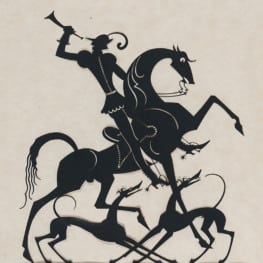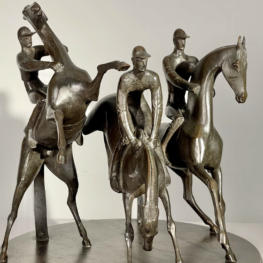Hunt Diederich
1884-1953
William Hunt Diederich’s fascination with animals, which remained strong throughout his career, developed from his childhood encounters with the horses, stags, and exotic hounds that inhabited his family’s estate in Hungary. In their physical shape and unique characteristics, the artist found a form analogous to his governing aesthetic philosophy, declaring, “Animals seem to me truly plastic. They possess such supple, unspoiled rhythm.” The graceful lines, fluid movements and inherent nobility of these animals inspired the artist’s distinctive style and resulted in a range of exquisite wrought iron, bronze and paper silhouettes. At the age of sixteen, after studying for a time in Switzerland, Diederich moved to Boston to live with his maternal grandfather, the painter William Morris Hunt. Enrolled at the venerable Milton Academy, Diederich’s restless, independent nature clashed with the school’s traditional academic environment, and before long he dropped out and headed west, assuming the life of a cowboy on ranches in Arizona, New Mexico and Wyoming.
Upon his return to the East Coast in 1906, Diederich began studying sculpture at the Pennsylvania Academy of the Fine Arts; however, after two successful years there, during which he produced animal sculptures inspired by his Western experiences, he was expelled for “improper language.” Together with Paul Manship, a fellow sculptor he had befriended at the academy, he continued his artistic education through extensive travels in Europe. In particular, the young artist was inspired by the examples of Renaissance and Baroque iron work he encountered. With the outbreak of World War I, Diederich returned to the United States, where he settled in New York and began exhibiting his animal-themed works. Many of such themes were met with rave reviews and led to many commissions, including a series of weathervanes for the Central Park Zoo in 1934, replicas of which remain to this day.
Evolving out of his two-dimensional silhouette cutouts, Diederich’s wrought iron pieces combined the decorative with the practical. According to his daughter, Diana Blake, his “work in cast iron was a very important part of his life, perhaps the most important.” No doubt, the artist enjoyed the contrast between the dark, inflexible heaviness of the material and the lively, seemingly weightless designs that ultimately resulted.



